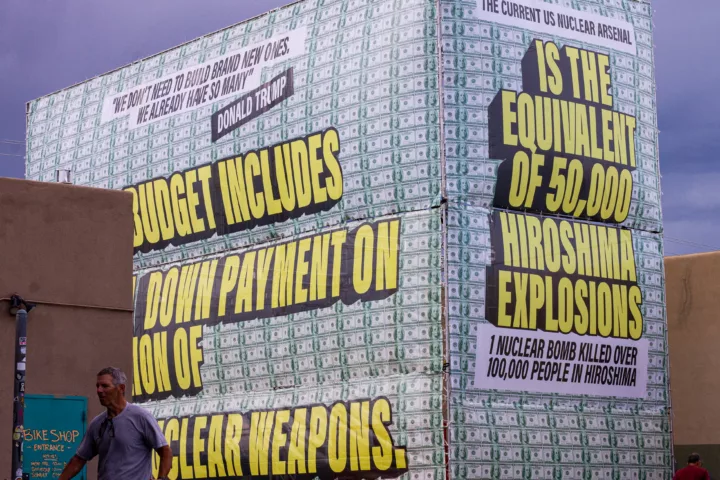The reviews are rolling in for “A House of Dynamite,” which premiered in Europe earlier this month before coming to the U.S. on October 10th, with a full Netflix release scheduled for the 24th. Here’s the trailer, and see the schedule for Santa Fe theater showings here:
This Week! Santa Fe Theater Screenings for the Film “A House of Dynamite”
I attended one of these screenings last night, and I’ll let the professional critic reviews give the gist:
The Kathryn Bigelow thriller looks at what might happen if a ballistic missile were headed to the U.S. The director hopes the movie will start a conversation. New York Times: At Venice, ‘A House of Dynamite’ Is Scarier Than Most Horror Films
“The Netflix thriller captures from multiple perspectives the White House response to an unattributed missile launch headed for a major U.S. city in the harrowing 20 minutes until projected impact…”An unrelenting chokehold thriller so controlled, kinetic and unsettlingly immersive that you stagger out at the end of it wondering if the world will still be intact.” ‘A House of Dynamite’ Review: Idris Elba and Rebecca Ferguson in Kathryn Bigelow’s Precision-Tooled, Viscerally Unsettling Nail-Biter
“Told from the perspective of soldiers at a remote Alaskan missile base, staffers in the White House situation room, military officials at US Central Command (CENTCOM), and the president of the United States, the film weaves an overlapping timeline to show how the United States would respond to a missile attack…The film doesn’t want viewers to ask themselves how to thwart a nuclear attack on the United States. Rather, it wants the viewer to question the value of having nuclear weapons at all. ‘None of this makes sense,’ the President (Idris Elba) bemoans, ‘Making all these bombs and all these plans.'”
“A House of Dynamite is a terrifying examination of how terribly wrong things can go even with highly competent people in charge…But that’s also not necessarily the world we’re living in…The film shows why the worst can happen, even when competent, well-meaning people are trying to do the right thing.
But what if competence and decency are in short supply?” A House of Dynamite: Bigelow’s latest thriller shows why nuclear bombs are only part of the danger
This film left me reeling with tension and anxiety and exactly as the Times article titles it, is scarier than most horror films. Unlike ‘Oppenheimer,’ which largely glorified the invention of the atomic weapon, ‘A House of Dynamite’ makes it impossible to ignore the threat that nuclear weapons pose to our world. Working backwards from perspectives, and focused on how we can actually improve our odds of keeping this story a fictional one, here is what struck me most about this film:
-
-
Only one person decides what happens. But the real threat isn’t one reckless leader — it’s a reckless system. The final segment of the film features the “nuclear football” heavily, a briefcase containing launch procedures and options. In the United States, the president holds the sole and absolute authority to order the use of nuclear weapons. In the film, there are many voices in the President’s ear, but two primary perspectives quickly emerge after the defense fails and the ICBM remains inbound to its U.S. target: “One side advocates a retaliatory strike; the other, nothing. ‘It’s surrender or suicide,’ one adviser tells the President,” – thebulletin.org. The military aide carrying the nuclear football is tasked with providing the President the list of options if retaliation is chosen. An absolute must-read, Daniel Ellsberg’s book “The Doomsday Machine” breaks down many of the themes in the film with pure and terrifyingly honest account of Cold War-era nuclear strategy. In terms of launch authority, he describes how the inherent instability of the delegated command structure of the nuclear apparatus makes accidental or unwanted war an ever-present danger.
-
In a brief, rare moment of comedic relief, the President in the film is shown questioning why he was prepped for everything a million times over including Supreme Court Justices coming back to life to get their jobs back, but nuclear war planning was all but left out. The aide beside him refuses to advise on what to do but provides an explanation of the book of options. Based on his experiences as a nuclear war planner in the 1960s, Daniel Ellsberg revealed in The Doomsday Machine that the secret war plans of that era were far more catastrophic and less controllable than the public and even some high-level officials understood. Nuclear dangers are far from a Cold War relic; the reality today is still a system built on a hair-trigger for planetary-scale destruction. The only way to eliminate nuclear risk is to abolish the weapons entirely. In a nuclear crisis scenario, even rational, thoughtful leaders are pressured into impossible split-second decisions. As Robert McNamara said about the Cuban Missile Crisis: “Rationality will not save us […] It was luck that prevented nuclear war.” The system itself is fundamentally unstable. We cannot afford to ignore this reality, we must tackle it head on.
-
-
In the room at U.S. Central Command, the military officials are at a loss after realizing they don’t know where the strike came from. A young officer is on the phone with Russia locked in a cat-and-mouse on commitments to stand down that ends in nothing. If both the U.S. and Russia had “no-first-use” policies, this white-knuckle call would not have needed to happen. Yet currently both countries leave open the option of a nuclear first strike. The U.S. needs a “no-first-use” policy in order for Russia to follow suit. Furthermore, today, just one treaty, called New START, remains that puts restrictions on US and Russian nuclear arsenals. Without urgent action, we risk a new arms race and a collapse of decades of nuclear restraint. We must demand our leaders to turn down the temperature on nuclear risk and take concrete steps toward nuclear disarmament. The U.S. must renew and expand arms control treaties, starting with extending New START and pursuing new agreements with China and Russia.
-
Shock and denial are main players in the earlier parts of the film, at the Alaskan missile base and the White House situation room. “I always thought just being ready is the point…If they see how prepared we are, no one starts a nuclear war.” This quote describes the modern-day basis of nuclear deterrence, but being prepared hasn’t always kept us from the brink of nuclear war. On the contrary, it has brought us closer. Nuclear war planning is why we have thousands of warheads instead of just a few 100 for “deterrence.” The nuclear “modernization” program we’re now deeply in is essentially nuclear weapons forever, because of deterrence. The U.S. is rebuilding existing warheads with new military capabilities, creating new-design nuclear weapons that can’t be tested (or could prompt U.S. to resume testing), new nuclear weapons production facilities are expected to be operational until ~2080, and new heavy bombers, intercontinental ballistic missiles, new cruise missiles and new strategic submarines are building developed to deliver new warheads. All exceed budgets at enormous expense.
-
Deterrence is the Threat: NukeWatch Presentation for Western New Mexico University – April 1, 2025
-
-
Missile defense can’t save us from a nuclear attack, or prevent nuclear war. As shown in the film, missile defense is a dangerous illusion, not a smart, reliable solution. The task of missile defense is described in A House of Dynamite as “hitting a bullet with a bullet,” followed later by the Secretary of Defense asking (yelling), “So it’s a fucking coin toss? That’s what 50 billion dollars buys us?” Existing nuclear missile defense systems often fail, even with ideal conditions during highly simplified tests, even against only a single target (a realistic attack scenario could involve hundreds or even thousands of missiles).
-
“From the days of the Cold War to the recent proposals for a “Golden Dome,” billions of dollars (far more than the movie’s $50 billion price tag — in fact, most reliable estimates range from $300 -400 billion) have produced little actual protection. “Golden,” by the way, is an apt adjective, as gold is costly but as a soft metal, a poor choice for protection. The current system protecting the continental United States from ballistic missiles of the type depicted in the film has an estimated success rate of just over 50% (a “coin flip”) when facing fast moving ballistic missiles” – armscontrolcenter.org.
-
“‘House of Dynamite’ is a fictional film, for sure, but when it comes to the latest missile defense scheme, Golden Dome, the truly fictional portrayals are coming from the White House, the Air Force, and the contractors that stand to profit from it.” – forbes.com
-
-
In conclusion, this truly is a one-of-a kind film worth watching. Manohla Dargis writes in the most recent Times review, “A propulsive thriller, her latest movie hinges on a potential nuclear catastrophe of such annihilating magnitude that it seems almost inconceivable, despite being altogether credible” nytimes.com. What can we do to ensure this scenario remains a fictional one? Our world is incredibly fragile. Even when the system is operating exactly like it is designed, even when—as in the movie—our leaders do “everything right,” it cannot protect us from nuclear war. Humanity cannot coexist with nuclear weapons forever. We MUST abolish them, we have to dismantle the system that promises mass annihilation. There is no other option. Take action with our partner the Union of Concerned Scientists to dismantle this house of dynamite. We are calling on Congress to stop dangerous and unnecessary plans to carry out the most expensive expansion of the US nuclear weapons complex in history, including making hundreds of new plutonium “pits”—the explosive cores for new nuclear weapons.
Learn more:


